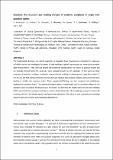Files in this item
Excitonic fine structure and binding energies of excitonic complexes in single InAs quantum dashes
Item metadata
| dc.contributor.author | Mrowiński, P. | |
| dc.contributor.author | Zieliński, M. | |
| dc.contributor.author | Świderski, M. | |
| dc.contributor.author | Misiewicz, J. | |
| dc.contributor.author | Somers, A. | |
| dc.contributor.author | Reithmaier, J. P. | |
| dc.contributor.author | Höfling, Sven | |
| dc.contributor.author | Sęk, G. | |
| dc.date.accessioned | 2016-09-02T16:30:08Z | |
| dc.date.available | 2016-09-02T16:30:08Z | |
| dc.date.issued | 2016-09-26 | |
| dc.identifier | 245527746 | |
| dc.identifier | ce7f3be4-e72c-4e77-a073-ee293a0a07f2 | |
| dc.identifier | 84990966935 | |
| dc.identifier | 000384065700008 | |
| dc.identifier.citation | Mrowiński , P , Zieliński , M , Świderski , M , Misiewicz , J , Somers , A , Reithmaier , J P , Höfling , S & Sęk , G 2016 , ' Excitonic fine structure and binding energies of excitonic complexes in single InAs quantum dashes ' , Physical Review. B, Condensed matter and materials physics , vol. 94 , no. 11 , 115434 . https://doi.org/10.1103/PhysRevB.94.115434 | en |
| dc.identifier.issn | 1098-0121 | |
| dc.identifier.uri | https://hdl.handle.net/10023/9423 | |
| dc.description | P.M., J.M. and G. S. acknowledge support from the grant of National Science Centre of Poland No. 2011/02/A/ST3/00152 (Maestro), whereas M.Z. acknowledges support from the Polish National Science Centre under grant No. 2015/18/E/ST3/005 (Sonata Bis). The experiments have partially been performed within the Wroclaw University of Science and Technology laboratory infrastructure financed by the Polish Ministry of Science and Higher Education Grant No. 6167/IA/119/2012. | en |
| dc.description.abstract | The fundamental electronic and optical properties of elongated InAs nanostructures embedded in quaternary InGaAlAs barrier are investigated by means of high-resolution optical spectroscopy and many-body atomistic tight-binding theory. These wire-like shaped self-assembled nanostructures are known as quantum dashes and are typically formed during the molecular beam epitaxial growth on InP substrates. In this work we study properties of excitonic complexes confined in quantum dashes emitting in a broad spectral range from below 1.2 to 1.55 μm. We find peculiar trends for the biexciton and negative trion binding energies, with pronounced trion binding in smaller size quantum dashes. These experimental findings are then compared and qualitatively explained by atomistic theory. The theoretical analysis shows a fundamental role of correlation effects for the absolute values of excitonic binding energies. Eventually, we determine the bright exciton fine structure splitting (FSS), where both the experiment and theory predict a broad distribution of the splitting varying from below 50 to almost 180 μeV. We identify several key factors determining the FSS values in such nanostructures including quantum dash size variation and composition fluctuations. | |
| dc.format.extent | 10 | |
| dc.format.extent | 951341 | |
| dc.language.iso | eng | |
| dc.relation.ispartof | Physical Review. B, Condensed matter and materials physics | en |
| dc.subject | QC Physics | en |
| dc.subject | NDAS | en |
| dc.subject.lcc | QC | en |
| dc.title | Excitonic fine structure and binding energies of excitonic complexes in single InAs quantum dashes | en |
| dc.type | Journal article | en |
| dc.contributor.institution | University of St Andrews. School of Physics and Astronomy | en |
| dc.contributor.institution | University of St Andrews. Condensed Matter Physics | en |
| dc.identifier.doi | 10.1103/PhysRevB.94.115434 | |
| dc.description.status | Peer reviewed | en |
This item appears in the following Collection(s)
Items in the St Andrews Research Repository are protected by copyright, with all rights reserved, unless otherwise indicated.

